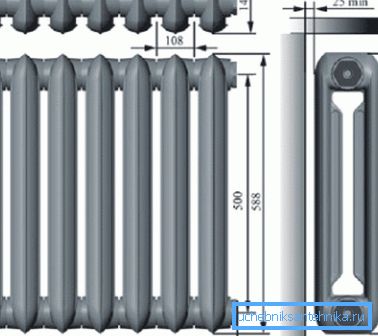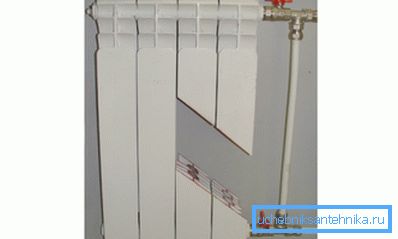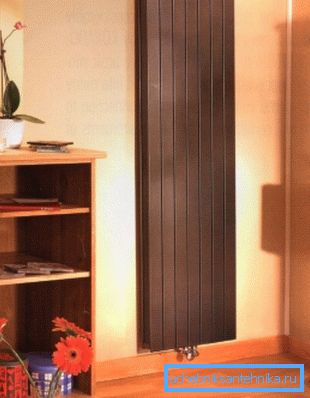What is the center distance in radiators: the dimensions of
The distance between the headers of the radiator is one of the important technical characteristics on which the dimensions of the product depend. Dimensions affect the ability to install, especially if the battery is planned to be placed in a niche or under the window. Correctly chosen size of the product will not violate the basic operational standards on which the normal heat transfer depends.

General overview of types of radiators and their dimensions
There are several main groups of radiators that differ in design features:
- Sectional.
- Panel steel and bimetallic.
- Convector.
- Author's models, custom-made, having no similar forms, but performing their functions.

The material used and the design features of the heating devices determine:
- resistance to water hammering;
- corrosion;
- fouling and scaling;
- heat transfer intensity and other components of success.
As for the size, the difference in height between the upper and lower manifolds (center distance) affects the ability to install the heater. Most often, they are installed in the niches under the windows, if the window opening is large enough, then the high battery simply does not fit.

This parameter is especially important for systems with natural circulation. The fact is that the pressure in the system is created due to the difference in height between the water supply to the battery and the boiler; the higher this value is, the greater is the natural pressure in the pipes.
Note! For example, the center distance of radiators of 250 mm makes sense to choose only under very low window sills. In this case, you can install the battery even under the window sill height of 50-60 cm.

Panel heaters are all-welded with a coil-coolant between two ribbed panels with a gap between them up to 1 cm. Such a surface increases the area of the heated surface and its heat transfer - radiation plus convection. The meager capacity contributes to rapid heat transfer - the efficiency reaches 75%, but they also cool down quickly.
The lack of panel products is:
- in their vulnerability to water hammer, which makes them unsuitable for use in central heating systems;
- corrode from acidic water;
- it is impossible to drain water for a long time because of the same corrosion, but already in contact with oxygen.
Sectional batteries are good opportunities for their constructive changes - increase / decrease in the number of sections for power changes or repairs. Bimetallic devices have replaced the traditional fragile but durable cast iron with high inertness.

In them, the coolant passes through steel tubes having aluminum fins with high thermal conductivity.
The bimetallic battery is the embodiment of two advantages in one product, namely:
- steel withstands unstable pressure and aggressive environment;
- Aluminum reacts immediately to temperature changes.
Note! Of the shortcomings, we can only note the cost. The price of a bimetallic radiator can be 2-3 times higher than that of cast iron or steel.
When choosing bimetallic batteries one has to take into account the diameter of the vertical and horizontal channels, and not only the center distance. As for the dimensions, the most popular can be considered models with a difference between the nipple holes of 500 mm (with the total height of the heater is 570 mm).

But in vacuum batteries the concept of "center distance" simply does not exist. The fact is that they use only 1 flow tube through which coolant circulates, and a uniform heating of the surface is achieved due to the evaporation of boiling liquid.
Tubular batteries - registers, superior sectional in compactness and variety of forms. The absence of leaks at the joints is ensured by welding the fragments, they withstand the working pressure of up to 15 atm., But thin walls do not hold the water hammer poorly. Registers it is possible to make their own hands, choosing an arbitrary pitch between the pipes.
Read more about radiator dimensions
In the technical documentation for heating devices in addition to heat output, the dimensions as well as the center distance must also be indicated. Depending on the type and the manufacturer, the dimensions of the heaters may vary.
Bimetallic radiators
Of all battery sizes, the distance between the collectors can be considered decisive - it is the size of the product that depends on it. And if the length of the sectional devices can be varied, then the height can become a stumbling block. This parameter is indicated by a number after the model name, for example, ALUX 200. The standard center distance for aluminum radiators is 350 and 500 mm, but this figure can vary from 200 to 800 mm.

For example, in Italian sectional models ALUX 200 with the same height of 245 mm and a depth of 100 mm each section is 80 mm long with a power of 92 W. The maximum length is 1280 mm (16 sections) with a power of 1472 watts. The ALUX 350 model with a height of 395 mm has the same dimensions and number of sections, with a power of 138 W, the ALUX 500 has a height of 545 mm with a power section of 179 W.
The standard size range of bimetallic batteries includes center distances from 200 to 500 mm. But the height of the device may differ slightly depending on the manufacturer. For example, if this parameter is 500 mm, the height of the Rifar Monolit is 577 mm, and that of the Germanium Neo model - 560 mm.
Bimetallic radiators with a 450 mm center distance are not available. So it is necessary to get the heating device closest in size.

Note! If the height of the pipes does not correspond to the center distance, you can always reduce or dilute them. It is only important that the transition be smooth, and not at an angle of 90 ?.
In addition to 2 horizontal tubes, the design of the bimetallic radiator also provides thinner vertical steel tubes through which coolant circulates. But in low models they may not be. For example, when the height of the heating device is about 20 cm, it will also warm up well from 2 horizontal pipes.

Cast Iron Radiators
Such models are considered classics and have been used for more than 150 years, of course, the appearance has undergone significant changes, but the idea itself remains the same. This type of battery even released a separate standard - GOST 8690-94.
According to this document, the range of distances between the nipple holes is from 300 to 800 mm, with the total height of the device being from 400 to 900 mm.

As for the varieties of such heating devices, models with 1, 2 and 3 channels are produced, the shape of the sections themselves may also differ. In order not to be confused when choosing a battery, simply know the features of the marking device.
According to GOST 8690-94, when marking, such radiator parameters are indicated as:
- its depth;
- the distance between the central axes of the nipple holes;
- Since the pressure in the heating system is significant, the maximum working pressure is also recorded in the marking;
Note! Cast iron is a fragile material, therefore it does not tolerate hydraulic shocks. If such phenomena are not uncommon in the heating system, it is better to refuse cast iron batteries and choose a steel or bimetallic analogue.
- indicates the number of sections, as well as the standard used.

If you want to choose a center distance of the heating radiator 450, then you can choose a battery with the closest value of this parameter 400 mm and slightly reduce the pipe. The standard does not provide for the release of heating devices with a distance of 450 mm between the nipple holes.

The labeling usually indicates the thermal capacity of one section. For example, the entry MS-140M-500-0.9 means that one section is able to give 140 W of heat, the center distance is 500 mm, the working pressure is 9 atmospheres.
Aluminum radiators
The main difference between aluminum radiators and bimetallic radiators is that the tubes, the frame along which the coolant moves, are made of aluminum alloy. In bimetallic they are made of steel or copper, and aluminum is used only for fins.

As for the size range, the minimum value can be considered 150 mm, and the upper threshold is limited to 800 mm between the axles of the nipple holes.
Accordingly, the size changes and battery power:
- baby height of 150 mm is suitable for homes with large windows, it will not block the view from the window. The set includes legs so that it is not necessary to fix it to the wall;
- large sizes of 700-800 mm have high heat transfer due to the developed surface of the radiator;
- but the most running can be considered the size of 400-500 mm between the axes of the nipple holes. These are the batteries used in most apartments.

We should also highlight the vertical radiators. If under the window to place the heating device is not very convenient, then the instructions for the design of the room allows you to place a vertical radiator in the corner. It is quite small in width (literally 5-7 sections), but here the height can reach 2 meters.

In the case of aluminum radiators, the center distance is from 1,200 to 2,000 mm. True, the efficiency of such a battery is somewhat lower compared to a conventional one, because part of it is located in the upper part of the room, where the temperature is somewhat higher than that of the floor.
Dimensions of steel radiators
Overall dimensions of panel steel radiators are in the range of 20–90 cm, and the axial distance is 5–7 cm less than the height. Devices with inter-axial distance of 450 mm are produced; this standard size is absent in cast-iron, bimetallic counterparts.
Steel radiators can also be vertical, the maximum height in this case may be 2-3 meters. But more often used conventional models.

Also registers are made of steel pipes (this is due to the ease of welding steel and its strength). But there are no restrictions for this type of heaters, and the diameter is selected on the basis of the customer's desire, as well as the heat transfer from the heater.

In conclusion
Center distance is an important parameter in any modern radiator. From this size depends on the height of the device, and hence the possibility of installing it in a niche under the window. The range of sizes of modern radiators will allow them to be installed both in a regular apartment and under a large window.
The video in this article contains a number of useful tips on choosing a heating radiator for your home.